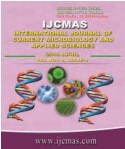


 National Academy of Agricultural Sciences (NAAS)
National Academy of Agricultural Sciences (NAAS)

|
PRINT ISSN : 2319-7692
Online ISSN : 2319-7706 Issues : 12 per year Publisher : Excellent Publishers Email : editorijcmas@gmail.com / submit@ijcmas.com Editor-in-chief: Dr.M.Prakash Index Copernicus ICV 2018: 95.39 NAAS RATING 2020: 5.38 |
Present study was conducted on genetic diversity using ISSR markers for a total of 40 landraces of little millet (Panicum sumatrense) collected from five different districts of Madhya Pradesh. Ten ISSR markers amplified total 42 loci while 32 loci showed 76.19% polymorphism. Maximum number (06) of alleles were scored by the primers UBC-807 whereas, minimum number of alleles (03) were scored by the primers UBC-816. Percentage of the number of polymorphic loci within population among the three regions, the highest frequency of polymorphism was found in the Dindori region (97.61) followed by the Betul region (80.95) and the lowest were in the Chhindwara region (40.47). Cluster analysis was estimated and a dendrogram was generated using Unweighted Pair Group Analysis (UPGMA). The highest genetic variability was observed between Amwa-38, Shivri-31 and Khaparipani-24 collected from Rewa and Dindori both of them grouped distantly. The highest PIC value (0.53) was observed by using primer UBC-853 having 06 alleles among the 40 landraces of little millets. The results indicated that ISSR marker system can be effectively used in determination of genetic relationship necessary for their conservation and breeding programs among the landraces of little millets grown in different districts of Madhya Pradesh, India.
 |
 |
 |
 |
 |